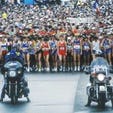
Joint Oil is an emulsified liquid fish oil designed to support joint mobility, comfort, and health in a delicious Tangerine Dream flavor.†
If you love to run and are interested in testing yourself with a race, you probably know that the 5K (3.1 miles) is the perfect distance to start with.
And if you’ve done one before, you also know that it’s no jog in the park—you need to train for it seriously to have a good performance.
Whether you’re revving up for your first race or you’re looking to score your best time ever, I’ve got a 10-week plan that makes it simple for you.
It’s so effective that you’ll only need to pound the pavement three days per week.
While most 5K programs out there focus on having you run fixed distances each workout, the best way to build your conditioning is to let your workout intensity be your guide.
That means you’ll adjust the length of your training in real time based on how hard you’re working, which allows you to target the specific energy systems (aerobic and anaerobic) involved in the race.
Self-regulating your training also ensures that you get a better cost-benefit ratio from your workouts, so you’re never working harder than what you can recover from.
Here’s How It Works
You can measure intensity by your heart rate or your perceived running speed. To find your max heart rate, subtract your age from 220. When you run, you’ll aim to keep your heart rate at a certain percentage of this number. So, if you’re 30 years old, your max heart rate will be approximately 190 beats per minute, and a workout calling for 80% of your max will be done at around 150 beats per minute. You can wear a heart rate monitor to keep track or estimate it by holding two fingers at the pulse in your neck. Count the beats for six seconds and then multiply by 10 to find the number in one minute.
If you go by your perceived running speed (which is more practical for certain workouts), use this 1–10 scale: 1 represents an easy slow jog and 10 an all-out sprint. A speed of five would then be a moderate-paced run.
In each session, you’ll be given a range of sets to perform, and the exact number you do will be determined by your ability to maintain the given intensity. If at any time your heart rate or speed changes by 15% or more, the workout stops there. So instead of trudging along for miles when your body isn’t up to it, and greatly raising your risk for overtraining and injury as a result, you’ll quit while you’re ahead. As a result, you’ll find that, overall, you have more energy when you run and you’ll log more “good” workouts than bad ones.
For example, if you’re supposed to be working at a pace that’s 80% of your max heart rate—let’s say that’s 150 beats per minute—and you notice that it’s jumped to 170 beats per minute (according to either your heart rate monitor or when you measure your own pulse), end the workout there. Continuing to train beyond the intensity needed to get the training effect that you want is simply counterproductive. Don’t be a hero and try to push through; listen to your body when it says you’ve had enough.
The same principle applies to the perceived speed scale. If you’re supposed to run at a 6 but you feel yourself having to slow down to more of a 4.5 (15% less than 6 on a scale of 1–10), stop. Be as objective as you can.
This kind of training can be an adjustment mentally. If you’re used to logging upwards of 25 miles per week, you’ll notice that self-regulating your workouts will have you running a little less. Trust that the quality of your training is more important than the quantity.
The Program
There are four workouts that you will rotate through for three sessions per week for 10 weeks. So you’ll do Workouts 1, 2, and 3 in Week 1 and pick up with Workout 4 in Week 2 and repeat the cycle. You can spread the workouts out however you like as long as you get them in the order shown. Weeks 1–5 will consist of the same workouts repeated, and you’ll switch to different routines in Weeks 6–10.
In your last week before the race, take 2–3 days completely off to ensure proper recovery.
Weeks 1–5
Workout 1
Run 90 seconds at 90% of your max heart rate (HR), or a perceived speed of 6–7. Rest 60 seconds. Repeat for 8–12 rounds, starting with 8 rounds in Week 1 and building gradually to 12 as the weeks go on and your intensity allows.
Workout 2
Run 10 seconds at a perceived speed of 10, then 20 seconds at a 5, or at least 80% of your max HR. Afterward, slow down to an easy jog or walk (a speed of 2) for 30 seconds. That’s one “rep.” Do 5 reps like this and repeat for 3 sets, resting 2 minutes between sets. Add a fourth set as intensity allows.
Workout 3
To do this workout you must first determine your race pace—the speed you intend to maintain for most of the 5K. Choose a goal time to complete the race and divide it by 5 so you have a goal for each interval. A good finish time for most beginners is 25 minutes. So, assuming that, you’ll want to aim to complete each kilometer of the race in 5 minutes.
Run 1,000 meters slightly faster than your race pace. If you’re trying to run the 5K in 25 minutes, you’d want to run these 1,000 meters at about 4 minutes and 40 seconds (1,000 meters = 1 kilometer). Rest 5 minutes and repeat for 2–3 sets. Work up to 5 sets over time as intensity allows.
Workout 4
Run at 60–65% of your max HR for 20–25 minutes.
Weeks 6–10
Workout 1
Run two minutes at 90% of your max HR, or a perceived speed of 6–7. Rest 60 seconds. Repeat for 8–12 rounds, starting with 8 rounds in Week 6 and building gradually to 12 as the weeks go on and your intensity allows.
Workout 2
Run 10 seconds at a perceived speed of 10, then 20 seconds at a 5, or at least 80% of your max HR. Afterward, slow down to an easy jog or walk (a speed of 2) for 30 seconds. That’s one “rep.” Do 5 reps like this and repeat for 5 sets, resting 2 minutes between sets.
Workout 3
Run 1,000 meters slightly faster than your race pace. Rest 5 minutes and repeat for 5 sets as intensity allows. Try to reduce your rest gradually between sets as intensity allows.
Workout 4
Run at 60–65% of your max HR for 20–25 minutes.



)





